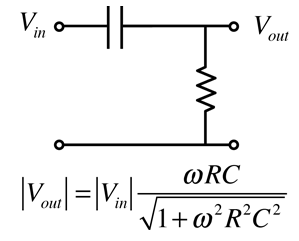RC High Pass Filter Calculation
Since capacitive reactance decreases with frequency, the RC circuit shown discriminates against low frequencies. The circuit is an AC voltage divider with an output which falls off at low frequencies at the rate of 6 dB per octave.
One approach to the design of a high-pass filter is to establish a frequency "breakpoint" or "knee" by choice of the resistance and capacitance.
The design calculation works by clicking on the desired quantity in the expression. Enter the necessary data and then click on the quantity you wish to calculate. Default values will be entered for unspecified quantities, but all quantities may be changed. After the filter has been designed, the amount of attenuation in decibels at any frequency can be evaluated by the separate calculation below. Once you get well below the breakpoint frequency, the amount of attenuation will increase by about 6dB per octave, which you can confirm with that exploratory calculation.
Breakpoint = 1/(ResistancexCapacitance)
|


